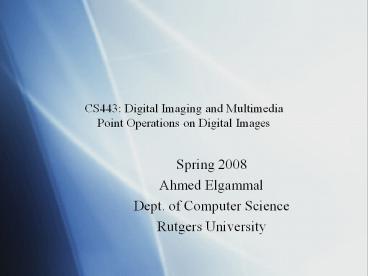CS443: Digital Imaging and Multimedia Point Operations on Digital Images - PowerPoint PPT Presentation
Title:
CS443: Digital Imaging and Multimedia Point Operations on Digital Images
Description:
... Digital Imaging and Multimedia. Point Operations on Digital Images ... Point Operations perform a mapping of the pixel values without ... photography ... – PowerPoint PPT presentation
Number of Views:220
Avg rating:3.0/5.0
Title: CS443: Digital Imaging and Multimedia Point Operations on Digital Images
1
CS443 Digital Imaging and MultimediaPoint
Operations on Digital Images
- Spring 2008
- Ahmed Elgammal
- Dept. of Computer Science
- Rutgers University
2
Outlines
- Point Operations
- Brightness and contrast adjustment
- Auto contrast
- Histogram equalization
- Histogram specifiation
3
Point Operations
- Point Operations perform a mapping of the pixel
values without changing the size, geometry, or
local structure of the image - Each new pixel value I(u,v) depends on the
previous value I(u,v) at the same position and on
a mapping function f() - The function f() is independent of the
coordinates - Such operation is called homogeneous
4
- Example of homogeneous point operations
- Modifying image brightness or contrast
- Applying arbitrary intensity transformation
(curves) - Quantizing (posterizing) images
- Global thresholding
- Gamma correction
- Color transformations
5
- A nonhomogeneous point operation g() would also
take into account the current image coordinate
(u,v)
6
- Changing contrast and brightness
- Limiting Results by Clamping
7
- Inverting Images
8
Threshold Operation
- Thresholding an image is a special type of
quantization that separates the pixel values in
two classes, depending on a given threshold value
ath - The threshold function maps all the pixels to one
of two fixed intensity values ao,a1 - Example binarization ao0,a11
9
(No Transcript)
10
Point Operations and Histograms
- The effect of some point operations on histograms
are easy to predict ex increasing the
brightness, raising the contrast, inverting an
image - Point operations can only shift and merge
histogram entries - Operations that result in merging histogram bins
are irreversible
11
Automatic Contrast Adjustment
- Auto-contrast a point operation that modifies
the pixels such that the available range of
values is fully covered. - Linear stretching of the intensity range - can
result in gaps in the new histogram
12
(No Transcript)
13
Better Auto-contrast
- Its better to map only a certain range of the
values and get rid of the tails (usually noise)
based on predefined percentiles (slow, shigh)
14
Histogram Equalization
- Adjust two different images in such a way that
their resulting intensity distribution are
similar - Useful when comparing images to get rid of
illumination variations - The goal is to find and apply a point operation
such that the histogram of the modified image
approximates a uniform distribution.
15
(No Transcript)
16
- Linear Histogram equalization
17
(No Transcript)
18
Histogram Specification
- Real images never show uniform distribution
- In most real images the distribution of pixel
values is more similar to a Gaussian Distribution - Histogram specification modifies the image to
match an arbitrary intensity distribution,
including the histogram of a given image. - Also depends on the alignment of the cumulative
histograms by applying a homogeneous point
operation.
19
Histogram Specification
- Find a mapping such that
20
Adjusting piecewise linear distribution
21
(No Transcript)
22
(No Transcript)
23
(No Transcript)
24
Adjusting to a given histogram
25
26
(No Transcript)
27
(No Transcript)
28
Gamma Correction
- What is the relation between the amount of light
falling onto a sensor and the intensity or
brightness measured at the corresponding pixel. - What is the relation between the intensity of a
pixel and the actual light emanating from that
pixel on the display? - The relation between a pixel value and the
corresponding physical quantity is usually
complex and nonlinear. - Approximation ?
29
What is Gamma?
- Originates from analog photography
- Exposure function the relationship between the
logarithmic light intensity and the resulting
film density. - Gamma is the slope of the linear range of the
curve. - The same in TV broadcasting
30
The Gamma function
- Gamma function is a good approximation for the
exposure curve. - The inverse of a Gamma function is another gamma
function with - Gamma of CRT and LCD monitors 1.8-2.8
(typically 2.4)
31
Gamma Correction
- Obtain a measurement b proportional to the
original light intensity B by applying the
inverse gamma function - This is important to achieve a device independent
representation
32
Gamma Correction































